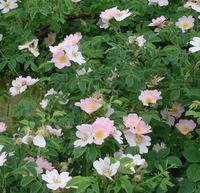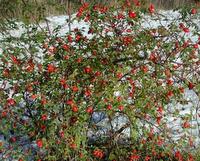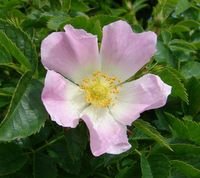





I recently found myself entangled in an impenetrable thicket in my son's backyard. It was my own fault, I had walked backwards playing with the little grandpuppy named Ruphus, and ended up on my backside with rose hips all around. It reminded me of a time long ago, when I ate rose hips straight from the bush.
The older I get, the more I remember things I thought were long forgotten. I don't know if this is good or bad, but I sometimes think a compromise might be needed. My husband once asked me if I thought I preferred living in the past, and I said, "Yes and No," "Typical woman," he said, "can't make up your mind."
The truth is I like both places, the past and the present. So many things I learned to do in the past are no longer relevant. Nobody makes shucky beans anymore, and store bought gingerbread is nothing like the real thing made with molasses and buttermilk. And nobody ever adds rose hip jelly to their grocery list. It might be that no one remembers them, but I do.
When I fell into the thicket of rose hips in the back of my son's yard in Illinois, I was immediately right back in the mountains helping my great aunt and my grandmother gather rose hips to make jelly. I fell into those dog rose thickets then, too. Actually we called it dog briar in those days. I only recently learned its real name.
Dog rose, Rosa canina, did not grow in abundance in the mountains of southeast KY, but sometimes it could be found growing wild in the sunshine on their south side. There were no garden nurseries in those days, at least none anywhere near me, so there were some folks who transplanted dog roses into their yards. A thicket of dog roses will keep the tiniest bunnies away. With enough sunshine, they are easy to grow. A lot of folks had them growing around the edges of the garden closest to their homes. It was not uncommon for families to have more than one garden. The acreage we owned was very nearly straight up the mountain, with very few level spots. Those flat places were perfect for gardens, but flat areas were few and far between. A large family gardened in every flat spot on its property, it didn't matter how far apart they were. In our closest garden, we had dog roses growing.
The dog rose is native to Europe, but is naturalized in much of eastern North America. It grows along sunny roadsides, woodsides, and hedges. It is a perennial shrub, growing usually as bushes or as thickets, six to ten feet tall, and sometimes even bigger than that. They don't have thorns such as we usually find on roses, theirs are fewer and hooked. The leaves are divided into oval leaflets and are smoother and greener than those of garden roses. It flowers from May through July, and the flowers are normally pale shades of pink, growing on long stalks. The flask shaped scarlet hips are as much as an inch long, and they are compound fruits consisting of single seeded fruits. 
In those days of making sure everything we tended had a purpose, the dog rose had two, and for me it had three. I particularly loved the soft pink blooms and tasty fruit, my Aunt Bett used its rose hips for medicine, and my Granny Ninna made rose hip jelly. Though its use in prescriptions goes back for hundreds of years, the dog rose came into full bloom as a medicinal plant only in World War II. Great Britain was unable to import fresh citrus fruits at that time, so the government organized the gathering of dog rose fruits, or hips, which were known to be rich in vitamin C. Processed into syrup, the rose hips helped to prevent scurvy in the isolated country where it was much needed, particularly for children.
Until that time the dog rose had been appreciated in modern times chiefly for its wild run of color through the countryside and for its ability to grow into impenetrable thickets. By autumn the hips are smooth skinned and fleshy, and are ready to be processed into jellies, tonics, and pills, as well as syrups. I think rose hip jelly is probably the most popular form.
It seems the term dog rose came from ancient Rome. Some physicians of that culture thought the root of the plant contained a medicine that could cure the bite of a mad dog. Some also used the leaves to apply as a poultice to heal wounds. Some declared it an astringent, and said it would reduce fevers. Actually, scientists do not believe it will do any of those things, but it is highly valued medicinally, almost exclusively as a rich source of vitamin C. I remember having eaten rose hip jelly, but my favorite memories are eating the bright orangish rose hips right off the bush. It ranks right up there with persimmons and pawpaws in my book.
I have searched and searched for my grandmother's rose hip jelly recipe. Like a lot of other things, it has disappeared. I did do some research and found one that seems to be similar to hers and I will share it with you:
Rose Hip Jelly
4 quarts of ripe rose hips
2 quarts of water
1 package of pectin crystals
5 cups of sugar
1/2 cup of lemon juice
Simmer rose hips in water until soft. Crush to mash and strain through a jelly bag. This should make about 4 cups of rose hip juice. Add to juice the lemon juice and pectin crystals and stir until mixture comes to a hard boil. Stir sugar in at once. Bring to a full rolling boil and boil for one minute, stirring constantly. Remove jelly from heat and skim off foam with a metal spoon. Pour jelly into hot sterilized jars. Yield: about 5 cups
There are several other rose hips recipes from the same website as listed below. Some sources tell us that hips from Rosa rugosa have the best spicy fruity flavor and are best to cook with. If you should decide to try either of them, I will be more than happy to do a taste test for you.
You can find more recipes for rose hips here: http://homecooking.about.com/od/jellyrecipes/r/blfruit14.htm
Another source for reference: Magic and Medicine of Plants, the Reader's Digest Association, 1986.
You will also enjoy this article by Gloria Cole: http://davesgarden.com/guides/articles/view/710
All photos are from Plant Files, thanks to Todd_Boland for the first three and to Kniphofia for the last single bloom.
Copyright © www.100flowers.win Botanic Garden All Rights Reserved